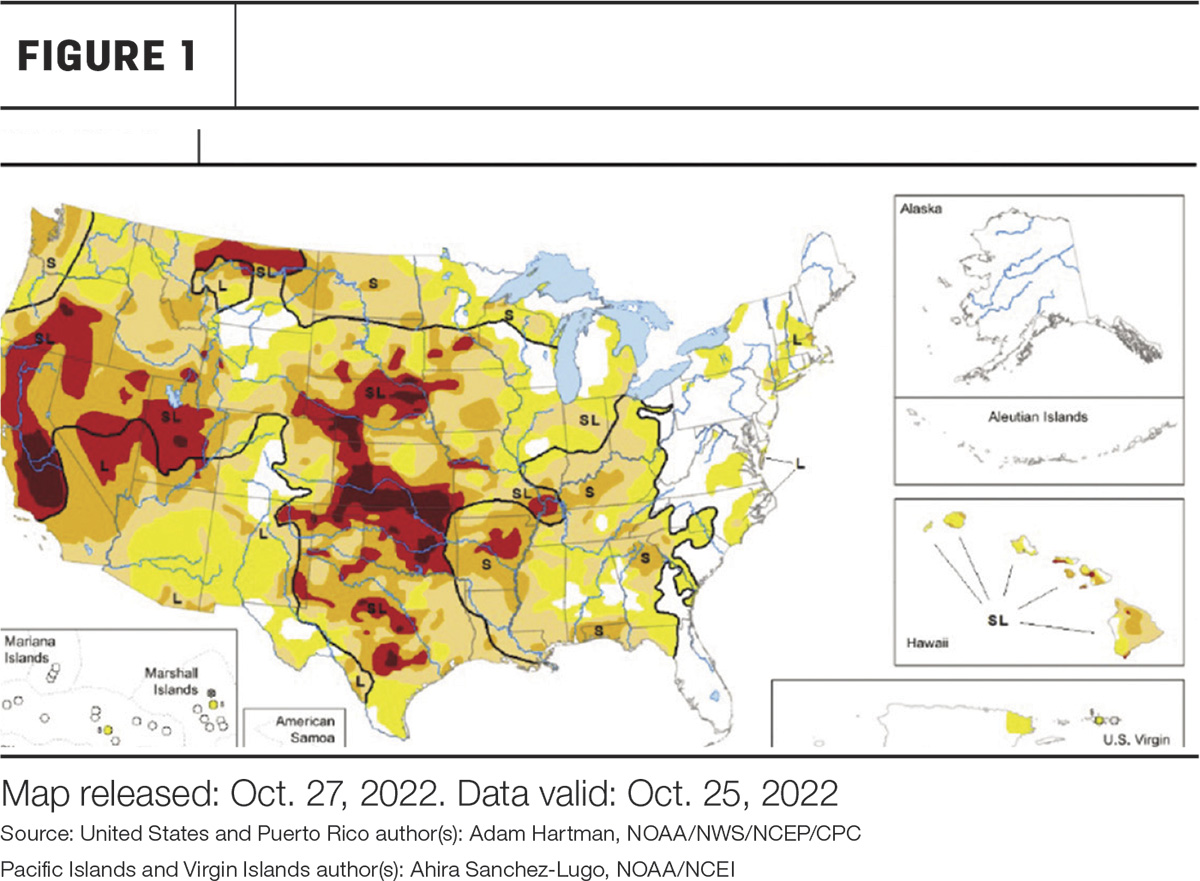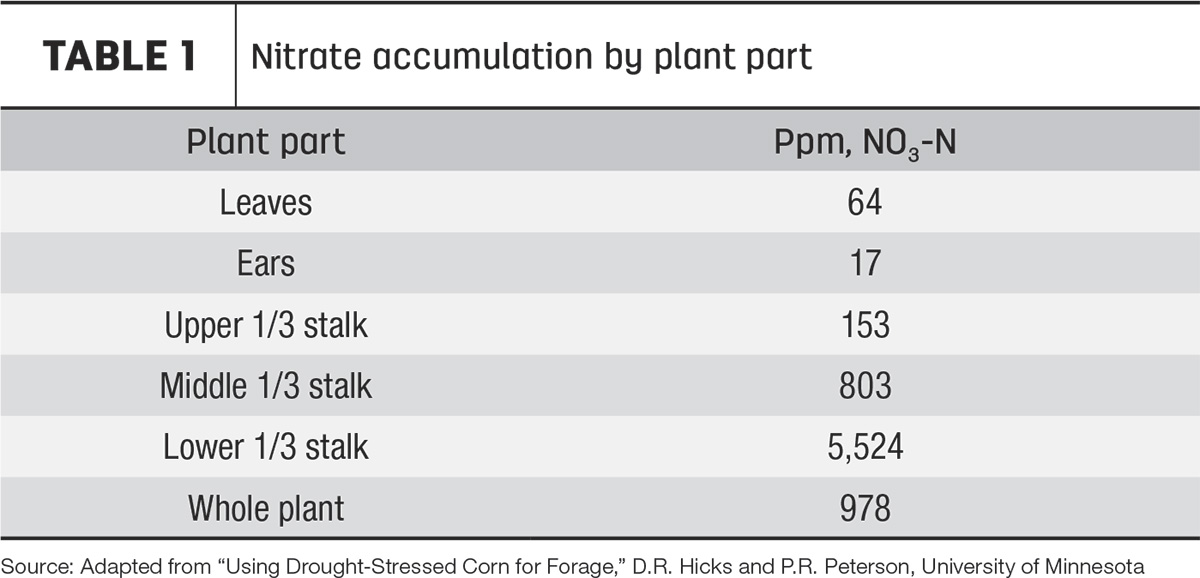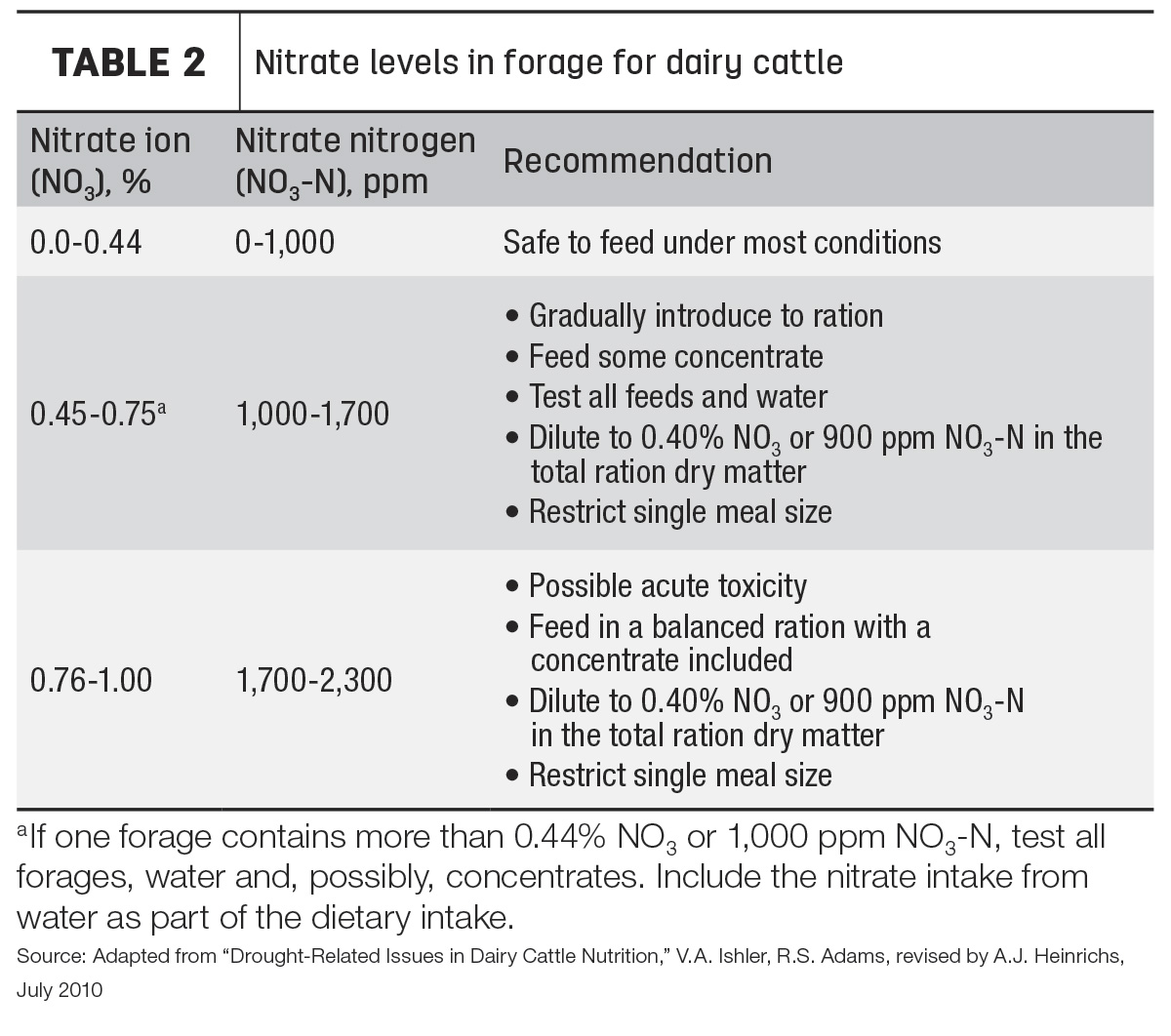The 2022 growing season has been quite variable in many parts of the country. Crops being grown for livestock feed have experienced moderate to severe drought stress in several geographical areas. In this article, we will look at what challenges to expect with drought-stressed corn silage and what to watch out for.
The definition of drought is “experiencing a prolonged period of time without rainfall.” Crops can be drought-stressed to varying degrees (as is illustrated in the U.S. Drought Monitor Report in Figure 1), and the severity of that stress can increase dramatically during hot, dry weather in a short period of time.

Some risks to be aware of in drought-stressed corn silages
Nitrates: Any forage harvested under drought conditions has the potential to contain elevated or toxic levels of nitrates. Nitrates are converted to nitrites in the rumen, and these nitrites bind with hemoglobin to form methemoglobin, which cannot carry oxygen, thereby depriving the body of oxygen. Fields that were heavily fertilized with nitrogen or experienced a heavy application of manure prior to planting are most likely to produce forages with high levels of nitrates in drought situations.
The following considerations could minimize the risk of nitrate toxicity in your livestock:
- Drought-stressed forages that have recently been exposed to rain are more likely to have high nitrate levels. As such, waiting to harvest 10 to 14 days after a significant rainfall will greatly reduce the chance of high nitrate levels in silages.
- Ensiling high-nitrate forages prior to feeding can reduce nitrate levels by converting more than half of the nitrates to ammonia, which can be utilized by the rumen.
- Nitrates accumulate heavily in the lower third of the plant (see Table 1).
 Practicing high chopping to leave more of the high-nitrate portion of the plant in the field will lower the overall nitrate levels but will also reduce the overall yield.
Practicing high chopping to leave more of the high-nitrate portion of the plant in the field will lower the overall nitrate levels but will also reduce the overall yield.
- Forages suspected of being high in nitrates should be tested. Evaluate the test results and utilize these forages based on the analysis you receive (see the guidelines in Table 2).

Molds and mycotoxins:
- Aspergillus produces aflatoxin, which is known to grow and multiply well in the hot, dry weather associated with drought conditions.
- Aflatoxins are harmful to cattle and can cause feed efficiency and reproduction problems, as well as suppression of the immune system.
- Aflatoxins are also carcinogenic to both cattle and humans, and FDA regulations require that there be no more than 0.5 parts per billion (ppb) of aflatoxins in milk for human consumption (aflatoxin M1).
- Aflatoxins are harmful to cattle and can cause feed efficiency and reproduction problems, as well as suppression of the immune system.
- Fusarium ear rot produces the fumonisin mycotoxins that are prevalent in a wide range of weather conditions, but high temperatures and drought stress before and after silking favor this toxin.
- Other mycotoxins that can be present depending on the weather conditions include DON, T-2 toxin, zearalenone and fumonisins.
Estimate drought corn yield
To estimate just how much a drought will affect your corn silage, it may be useful to do a yield assessment. Penn State University suggests taking the following steps:
- Estimate ears per acre: Measure 17 feet, 5 inches of a 30-inch row of corn; this is 1/1,000 of an acre. Count the ears in this length and multiply that number by 1,000. This will give you the ears per acre.
- Randomly pull three ears of corn from this measured area. Count the average kernels per row on each ear. Then, snap each ear in the middle of the cob and count the number of rows. (The rows should always be an even number.) Multiply the average kernels per row by the number of rows per cob to get the total kernels per cob.
- Multiply the number of cobs per acre by the number of kernels per cob. Divide this number by 90,000 (i.e., the number of kernels per bushel) to get the estimated corn yield per acre.
- Example: 14 kernel rows X 25 kernels per row X 25,000 ears per acre = 8,750,000 kernels per acre ÷ 90,000 = 97.2 bushels per acre (estimated)
- Example: 14 kernel rows X 25 kernels per row X 25,000 ears per acre = 8,750,000 kernels per acre ÷ 90,000 = 97.2 bushels per acre (estimated)
- If the yield estimates are around 50% of the normal amount, the level of additional corn energy fed will need to increase significantly depending on the sugar content of the corn silage.
Dairy ration considerations with drought-stressed corn silage
- Fiber levels can be higher – have a higher neutral detergent fiber (NDF) percentage; less grain means more plant material.
- Fiber digestibility (NDFD) may be higher and can allow for higher feeding rates to offset other forage inventory shortages.
- Sugar levels may also be higher and will offset a percentage of the extra starch supplementation needed in the ration.
- Typically, drought-stressed corn silage is lower in energy overall (from 80%-90% of a normal crop).
- Corn silage with little to no starch is also ideal for dry-cow and growing-heifer diets.
- The crude protein (CP) percentage will likely be higher.
- Low-starch, high-sugar corn silage will normally feed very well.
- The calcium and potassium levels will likely be higher.
- There is a possibility of elevated nitrate levels.
- Conducting a mold and mycotoxin analysis is critical to mitigate their potential effects on cattle.
- A wet chemistry laboratory analysis of these silages is highly recommended prior to feeding.
Drought-stressed corn silage harvest considerations
- Harvest moisture should be around 62%-68% for proper fermentation; moisture testing is required, as the plant stock moisture will still be deceptively high.
- Utilize an inoculant or forage treatment to ensure proper fermentation, as this will also help break down nitrates to ammonia.
- Delay the harvest of rained-on, drought-stressed corn plants for 10 to 14 days to minimize the elevated nitrate risk.
- Move the cutter bar higher to leave more of the high-nitrate stalk in the field to help minimize nitrate levels in the feed.
- Ensiling high-nitrate forages for a minimum of 21 days to allow for good fermentation prior to feeding is recommended to help convert as much nitrate to ammonia as possible.
- Test all suspect forages for nitrates prior to feeding and follow the recommendations for feeding elevated-nitrate forages as outlined in Table 2.
- Do not greenchop and immediately feed drought-stressed corn plants.
- Be safe: High-nitrate forage silages can lead to increased production of silo gas (i.e., nitrogen dioxide), so extra safety measures should be taken to ensure human safety near these stored silages.









